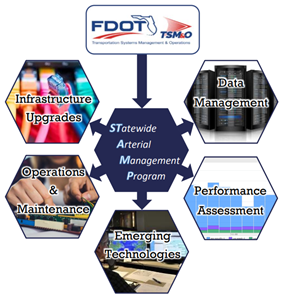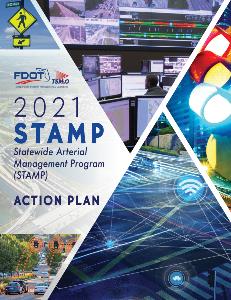Statewide Arterial Management Program (STAMP)
About
FDOT Transportation Systems Management & Operations (TSM&O) Strategic Plan identifies arterial management as one of six focus areas. The Statewide Arterial Management Program (STAMP) was created for collaboration and knowledge sharing to manage safety and mobility challenges faced on arterial roadways.
The STAMP supports the implementation, management, and operations and maintenance (O&M) of performance-based arterial networks. The STAMP focuses on TSM&O strategies such as active arterial management (AAM), integrated corridor management (ICM) and automated traffic signal performance measures (ATSPM) to provide for safe and efficient arterial networks. The STAMP addresses intelligent transportation systems (ITS) infrastructure and communication needs, transportation management center (TMC) needs, and O&M needs to support TSM&O strategies on arterials. The goal of the program is to achieve the throughput, efficient multi-modal operation, reduced travel time, increased traffic and bicycle/pedestrian safety and increased system uptime outcomes envisioned in the TSM&O Strategic Plan.
State Arterial Network


Initiatives
STAMP Action Plan
The 2021 STAMP Action Plan provides outcome-based actions intended to guide the collective arterial management efforts as well as the documentation progress. The STAMP Action Plan encourages the exchange of experiences, including collaboration and coordination. There is a total of five (5) Focus Areas and twenty-five (25) Action Items that are designed to guide the implementation process.
- Infrastructure Upgrades
- Operations and Maintenance
- Emerging Technologies
- Performance Assessment
- Data Management
 |
 |
Traffic Signal Maintenance and Compensation Agreement
The Traffic Signal Maintenance and Compensation Agreement (TSMCA) governs the traffic signal control devices on state arterials that are operated and maintained by local agencies. The agreement outlines the devices, maintenance requirements, compensation values and reporting standards for these devices.
Issue Papers
- Technical Memorandum: Advanced Signal Control Technology
- FDOT Traffic Signal Performance Measures
- Informational Guide - Design of Traffic Signal Detection Technologies (Sep 2022)
District Arterial Management Programs
District 4 District 5 District 6
Education
- What is Active Arterial Management (AAM)? The practice of applying mitigation tools to major signalized arterials with the goal of identifying crashes, causes for corridor backups, and maintenance issues that are impacting safety and capacity.
- What is Automated Traffic Signal Performance Measures (ATSPM)? A system that monitors signal performance by logging a suite of performance measures and uses analysis tools to support signal management, operations, and maintenance.
- What is Adaptive Signal Control Technologies (ASCT)? They adapt to real-time traffic conditions by continuously changing the green time movements received based on traffic demand. Using ASCT promotes mobility by decreasing both delay and congestion at signalized intersections, and by reducing the amount of wasted green time.
- What is Integrated Corridor Management (ICM)? A collection of operational strategies that support managing a transportation corridor as a system in an integrated and coordinated manner, rather than managing facilities or modes individually.
- Basic Elements of a Traffic Signal:

1) Traffic Signal Controller: alternates service between conflicting traffic movements by assigning green time between traffic movements
2) Loop Detector: places a call to the controller to service a specific movement when a vehicle is detected by the inductive loop or camera detector
3) Pedestrian Detector: places a call to the controller to service the pedestrian phase when a pedestrian is detected
4) Load Switch: uses a low voltage direct current output of the controller to switch a circuit on or off, thus turning on or off a signal display
5) Flasher(s): places the signal into flash (flashing yellow or red signals) when a necessary, for example, if the cabinet loses power or a malfunction of the signal is detected
6) Malfunctioning Management Unit (MMU): configured to check for conflicting signal indication and other various signal malfunctions. If a malfunction is detected, the MMU automatically turns the intersection into all way stop (flashing red) until conflict can be resolved
Training
The STAMP supports the development and dissemination of training
related to traffic signals and arterial management. See the Traffic Engineering
and Operations Office training page for access to those courses: https://www.fdot.gov/traffic/training

